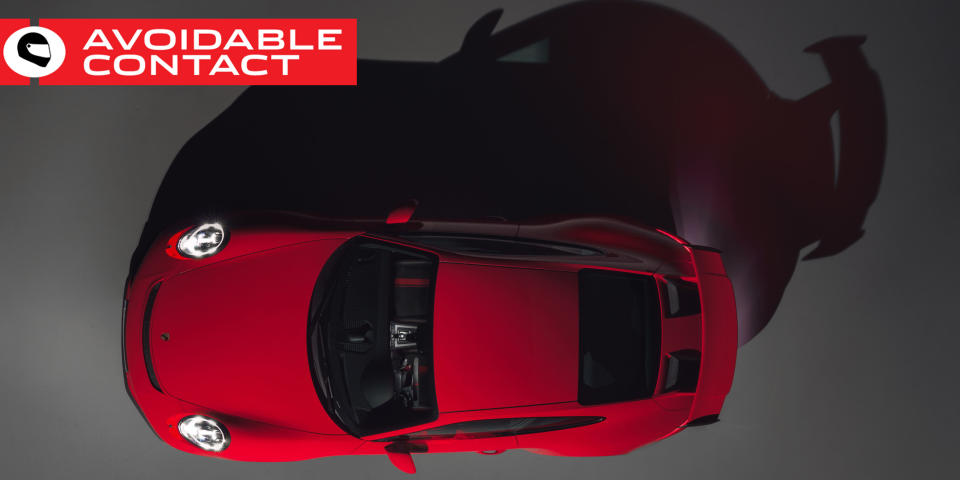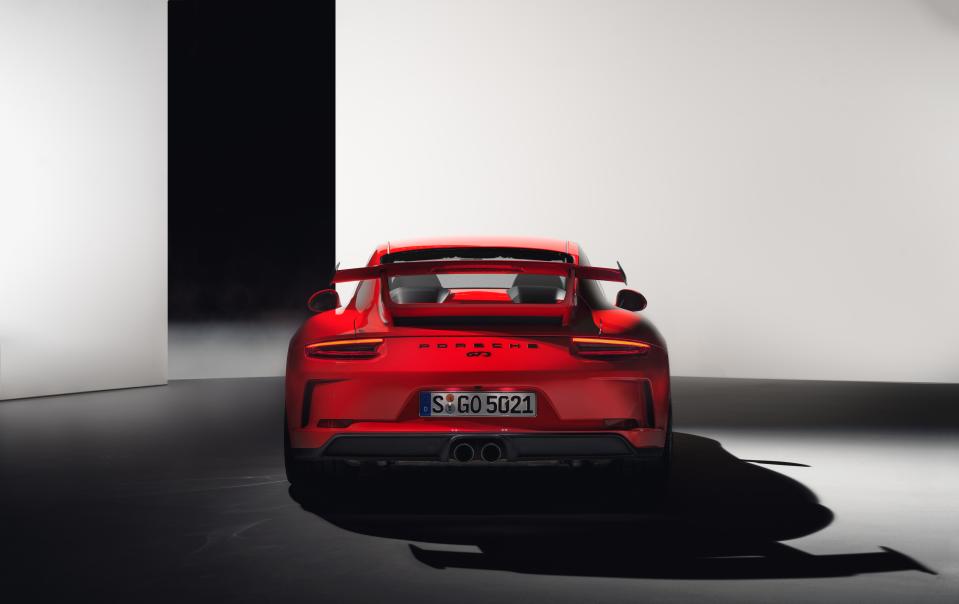When It Comes to Manual Transmissions, Porsche Is Crazy

When It Comes To Manual Transmissions, Porsche Is Crazy --- Like A Fuchs
Have you heard the news? Porsche is going to offer a manual transmission on its facelifted 911 GT3. But not on the next GT3 RS. This is a big deal because you couldn't get a proper stick shift on the first iteration of the 991-generation GT3. That didn't stop it from taking Performance Car Of The Year honors in 2015, but it has led to a bit of griping from Porsche's most devoted and frequent customers.
In my misspent youth, and in my early years as an owner of multiple Porsches, I quite admired the Stuttgart firm for the precision and single-minded focus evident in many of its products. Fifteen years later, I continue to admire Porsche-but now it's primarily for the CNC-milled exactitude of its marketing and public-relations efforts. Follow along with me, why dontcha, as I explain just how brilliant the company's decisions regarding this whole manual-transmission brouhaha have been.
Let's get this out of the way to start with: There was almost certainly never any technical reason not to fit the pre-facelift 991-generation GT3 with a manual transmission. As a former employee of a Northeastern-Ohio Porsche tuner that regularly put 800 horsepower, or more, through the bone-stock 997-generation manual transmission, I can attest that the existing hardware was absolutely up to the job of sitting between a relatively low-torque flat-six of middling displacement and the rear wheels.

There was, however, a marketing reason not to do it. And the reason went something like so: Porsche has been on the losing end of the supercar power wars for quite some time now. The 2015 Porsche GT3 barely squeezed enough juice to match a base Corvette Stingray. Hell, if you're one of those area-under-the-curve types, you could argue that the GT3 didn't match the Stingray. This is primarily important because you can get a Stingray for about fifty-something grand every day of the week at the Chevy dealer down the street from your house, while the GT3 cost about three times that much.
Note that I didn't say that the GT3 was slower than a Stingray. It wasn't, primarily because of two advantages. The rear-mounted engine that causes Porsche chassis engineers so much misery makes for brilliant sixty-foot times at a dragstrip. And the standard-equipment PDK transmission is much quicker, and more efficient, than the Corvette's standard torque-converter automatic or its optional seven-speed manual.
The PDK GT3 was able to threaten the contemporaneous Ferrari 458 in a straight line.
The GT3 worked those two advantages so effectively that it was able to threaten the contemporaneous Ferrari 458 in a straight line. But if you swap in a foot-clutched manual, that performance gap swells dramatically, and all of a sudden you might be looking at a heads-up stoplight race with your neighbor's Sunday-driver Stingray droptop. You know, the one with the chrome license-plate frame that says, in Gothic letters, "Old Guys Rule."
At this point I should mention just how unfair it is that Porsche should have to think about quarter-mile times at all. That's supposed to be the domain of the GT3's sibling-you know, the one with AWD and the "Turbo" badge. The one that runs ten-second quarters with the A/C on and the radio on Sirius/XM Channel 17, "Love." The GT3 is supposed to be the purist's choice, the Porsche for well-heeled track-savvy customers who are more likely to read the New York Review Of Books than they are obsessively peruse the quarter-mile trap speeds at the back of a car magazine. In the real world, however, these cars are all mostly sold to people who have no idea how to drive them and couldn't name a single important piece of Porsche corporate history if you held a Heckler und Koch P7M8 to their professionally-coiffed heads. So the quarter-mile time matters, because it's how the owners settle arguments during long nights at the hedge-fund headquarters.

Therefore the 911 GT3 must smoke through any and all instrumented tests. Not literally, mind you-they fixed that problem with the recall. But figuratively. The only problem is that there remains a certain cadre of potential owners who will turn up their noses at any "track car" with a PRNDL shifter, and there remains a much larger cadre of people who can't afford the car but who will talk smack about it and thus dampen the enjoyment of some potential owners. I'm an example of that second group; I regularly advised my well-heeled driving students to get a Viper instead of a 911 because in my opinion it's a more authentic, more interesting, and more challenging experience on-track.
Most car companies aren't smart enough to figure their way out of a bind like that, but Porsche absolutely is. These are the people, remember, who took a convertible top away from a car and charged the customers about five grand more for the privilege. They managed to get people to pay hundreds of dollars to get a different-color tachometer. They sell an optional battery that costs as much as an Armani sportscoat.
That's how we got the 911R, which was basically a stick-shift GT3 RS that cost more despite having less stuff.
That's how we got the 911R, which was basically a stick-shift GT3 RS that cost even more than a GT3 RS despite having less stuff. The dealers registered their displeasure at this hugely cynical move by marking the cars up an additional $100,000 above sticker, and the customers indicated their disgust with that strategy by immediately wiring funds from Geneva.
So Porsche managed to, in the infamous words of Samuel Johnson in the Lives Of The English Poets, "make an ornament of an inconvenience." First they sold all the automatic GT3s the market would bear, then they turned around and charged extra for the car they should have sold in the first place. Sheer genius!
There's not that much difference between the old GT3 and the new one, so if Porsche had simply introduced the car and mentioned the twenty-five extra horsepower, I doubt that anybody's pulse would have climbed above rest. The answer to this dilemma? Bring the manual transmission back! Now you can sell stick-shift GT3s to all the people who missed out on a 911R, and all the people who wanted a stick-shift in their pre-facelift GT3.

But the real, authentic, spellbinding wizardry came when Porsche's head of GT cars, Andreas Preuninger, told R&T that it "didn't make sense" for the GT3RS to have a manual. This means that we now have two so-called ultimate track Porsches. There's the stick-shift GT3 for the people who value involvement, and the PDK-equipped RS for the people who want the lowest lap time they can get with a Stuttgart crest on the hood and a license plate on the back. Where does that leave the "plain" PDK-equipped GT3? Who cares? It wasn't really big news anyway.
The only people who could have any possible complaint with this strategy are the existing 911R owners, but they can always reassure themselves that they have the most characterful version, which is probably true. And they can rest easy regarding their resale value, because the existence of the stick-shift GT3 suggests that there won't be another 911R in this generation. Everybody's a winner.
Not even the most feverishly marked-up 911R is worth as much as a ragged 1991 911 that has been given the Singer treatment.
There's just one little hitch to all of this: Not even the most feverishly marked-up 911R is worth as much money as a ragged old 1991 Porsche 911 Carrera 4 Targa that has been given the Singer treatment. Porsche is in the unique, and unpleasant, position of having a significant number of wealthy buyers who prefer the air-cooled cars. Nearly every automaker in the world was in this position during, say, 1980, but everybody else has climbed out of the hole. Example: If you find anybody who would rather have a 1991 Corvette than the current Stingray, back away from them slowly while pretending to be armed, because they are mentally ill. The same goes for a Magnum, P.I.-spec 308GTS against the current 488GTB. But Porsche can't dismiss its back catalog quite so easily. Those old cars really satisfy in a way that the new product can't quite duplicate.
Now you've got Ruf building new cars with classic air cooled looks, which suggests that others will follow. Sooner or later, some enterprising fellow is gonna figure out how to deliver 95 percent of the Singer experience for the same price as a brand-new 911 GT3. At that point, Porsche may have to figure out a way to be even more brilliant-but what does it say about a company, or a product, when its biggest potential competition is the older version of itself?
Born in Brooklyn but banished to Ohio, Jack Baruth has won races on four different kinds of bicycles and in seven different kinds of cars. Everything he writes should probably come with a trigger warning. His column, Avoidable Contact, runs twice a week.
You Might Also Like

 Yahoo Autos
Yahoo Autos 